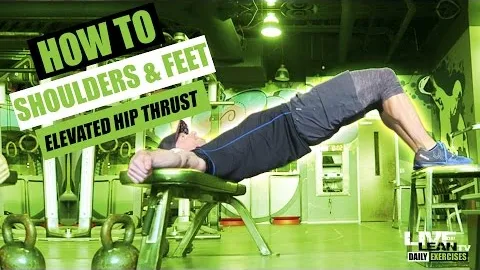
Shoulders and Feet Elevated Hip Thrust: A Powerful Exercise for Building Strong Glutes
The shoulders and feet elevated hip thrust exercise is a highly effective workout that targets the glutes, hamstrings, and core muscles. It is an excellent addition to any strength training routine, as it helps develop powerful and well-defined glute muscles while improving overall lower body strength and stability.
The hip thrust exercise has gained immense popularity among fitness enthusiasts and athletes due to its ability to activate and strengthen the gluteal muscles to a great extent. By incorporating the shoulder and feet elevation variations into your workout routine, you can experience enhanced results and further amplify the benefits.
The primary muscle group targeted during shoulder and feet elevated hip thrusts is the gluteus maximus, the largest muscle in the buttocks. This muscle plays a crucial role in stabilizing the pelvis, supporting the back, and improving overall athletic performance. By focusing on this muscle group, you can achieve a rounder, firmer, and more powerful-looking backside.
The hip thrust exercise, in general, aids in strengthening the posterior chain muscles, which include the glutes, hamstrings, and lower back. By specifically elevating the shoulders and feet, you create a more challenging and intense version of the hip thrust, activating these muscles even more. Strengthening these muscles not only helps improve posture but also enhances stability and prevents injuries during other compound movements like squats and deadlifts.
Strong glutes are essential for athletes participating in sports that require explosive movements, such as sprinting, jumping, and weightlifting. The shoulders and feet elevated hip thrust exercise helps develop power in the glutes, allowing athletes to generate more force and explosiveness in their movements. This exercise is particularly beneficial for runners, soccer players, and basketball players.
Weak glutes are often associated with lower back pain, as they contribute to poor hip and spinal alignment. Regularly performing shoulder and feet elevated hip thrusts can help alleviate this pain by strengthening the glutes, which will provide better support to the lower back and distribute the load more evenly during daily activities.
Like any exercise, it is important to perform shoulder and feet elevated hip thrusts with proper form to maximize the benefits and prevent injuries. Here is a step-by-step guide on how to execute this exercise correctly:
To make the most out of your shoulders and feet elevated hip thrust workout, here are some helpful tips:
Incorporating shoulders and feet elevated hip thrusts into your workout routine can significantly help in strengthening your glutes, improving posture and stability, enhancing athletic performance, and preventing lower back pain. By following the correct form and technique, gradually increasing the load, and incorporating variations, you can unlock the full potential of this exercise. Remember to stay consistent, stay focused, and enjoy the journey to building strong and powerful glutes.
If you're looking for a gym, fitness club or yoga studio, you've come to the right place.
You can find information about gyms in your area. Browse catalog of gyms and find gyms with classes which are you looking for.
On gym page you can find simple information like address, phone or website. You can find list of available classes. You can check availability of personal training or small group classes. On place page you can also see information about open hours.
You can find gyms near you with amenities, courts, studios and equipments.
Use our map to find gym at your city or district.
In Gym Navigator you can find list of exercises with movies for many body parts.
You can browse exercises catalog and find exercises the best of you.
You can also find exercises grouped into workout plans, which you can use to improve you body. Each routine show you exercises one by one and give you possibility to count you progress and count down rest time.